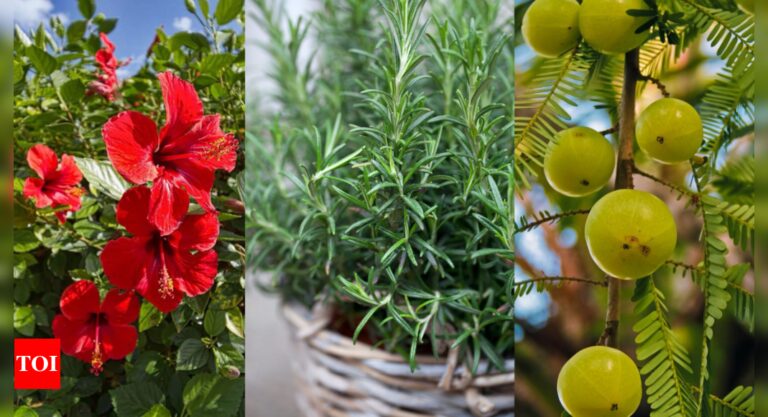(Image courtesy: Pinterest) The pursuit of healthy hair without side effects is the dream of almost every girl. Our hair care routine always changes from time to time, focusing on dandruff and split ends or simply growing strong and long hair. By using a ton of oils and treatments and changing shampoos again and again, people end up in an atmosphere of seeking natural help that mostly has no side effects and gives great results.
Natural remedies are a great way to maintain and achieve a clear scalp and long hair without harming your hair. Nature is home to many plants with amazing hair care properties and they have been used since ancient times. They are used in oils, shampoos and hair masks for better results. Plants are a natural approach to treat many problems, especially hair growth problems. Learn about 5 natural plants that have amazing effects on hair growth and how to use them in your hair care routine.
Aloe Vera
One of the most versatile and commonly used plants for hair and skin, aloe vera is a very unassuming plant, but it is packed with hair care benefits and is used in several hair care products. The gel extracted from this plant can be used directly and combined with various natural ingredients to treat hair problems. The pH level of this plant is very low, making it perfect for the scalp and not harmful to it. Aloe vera gel also contains minerals, copper and zinc, which help cure dandruff and promote hair growth.
(Image courtesy of Pinterest)
How to use –
Step 1: Extract natural aloe vera gel and add 2-3 teaspoons of coconut oil.
Step 2: Massage thoroughly for 30 minutes and wash with an aloe vera shampoo.
Step 3: Finish washing your hair with a good quality conditioner and check the results.
Rosemary
Rich in antibacterial, antioxidant and vitamins, rosemary is one of the most effective and powerful herbs for hair growth, increasing circulation and encouraging hair growth. It also moisturizes and conditions the scalp, slowing premature hair loss and relieving itchy scalp. When taken as an oil, it not only increases circulation, but when used with a carrier oil, it can also help prevent premature greying of hair.
How to use –
Step 1: Massage rosemary oil directly into your scalp or dilute it with other carrier oils like coconut oil or almond oil for better benefits.
Step 2: Leave on for an hour or overnight and rinse with a good quality shampoo and conditioner. Then pat dry.
hibiscus
Rich in flavonoids and amino acids, the time-honored Hibiscus flowers and leaves stimulate blood flow to hair follicles, encouraging new hair formation. These amino acids also promote healthy hair growth by promoting keratin formation around hair follicle cells and protecting hair from UVB rays. They also reduce scalp oiliness, preventing dandruff and split ends. By trapping moisture in the hair shaft, hair becomes more flexible, perfect for strong hair growth.
How to use –
Step 1: Take 3-4 hibiscus flowers and boil them with water.
Step 2: Strain the water and use it as a mist on your scalp daily to see results. You can also add this mist to the oil and apply it twice a week.
Amla (aka gooseberry)
One of the most nutritious and popular plants for hair care, Amla has a wide range of medicinal properties. It can be used in oils, shampoos or raw, and acts as a natural conditioner, strengthening hair and promoting hair growth. It is rich in Vitamin C, which helps in the production of collagen protein and regenerates hair follicles by replacing dead cells with new ones, aiding in the hair growth process.
How to use –
Step 1: Squeeze some amla juice directly onto your scalp and massage for five minutes.
Step 2: Leave it on for 10 minutes and then wash it off with lukewarm water and a good quality amla shampoo.
Bacopa, also known as Brahmi
Brahmi helps to achieve strong, bouncy hair with gorgeous ends. It stimulates blood circulation in the scalp, helping hair grow longer and thicker and also acts as a natural protectant. It reduces the risk of split ends, adds overall shine to your hair and also reduces scalp infections, irritation and itchy dandruff problems.
(Image courtesy of Pinterest)
How to use –
Step 1: Brahmi leaves are dried and ground with a carrier oil to make fine pastels.
Step 2: You can also add herbs like tulsi, amla, neem etc.
Step 3: Apply this paste and leave it for an hour and wash it off with lukewarm water and shampoo.
From Avocado to Zinc: Key Nutrients for Healthy Skin and How to Get Them
These plants can be easily found around us or you can even grow them yourself. They can be used as oils, shampoos or hair masks and can also be mixed with other natural ingredients. To get the desired results, you should use these products at least two or three times a week. You can also find products that contain these natural ingredients so you can incorporate them into your hair care routine.
Source link

